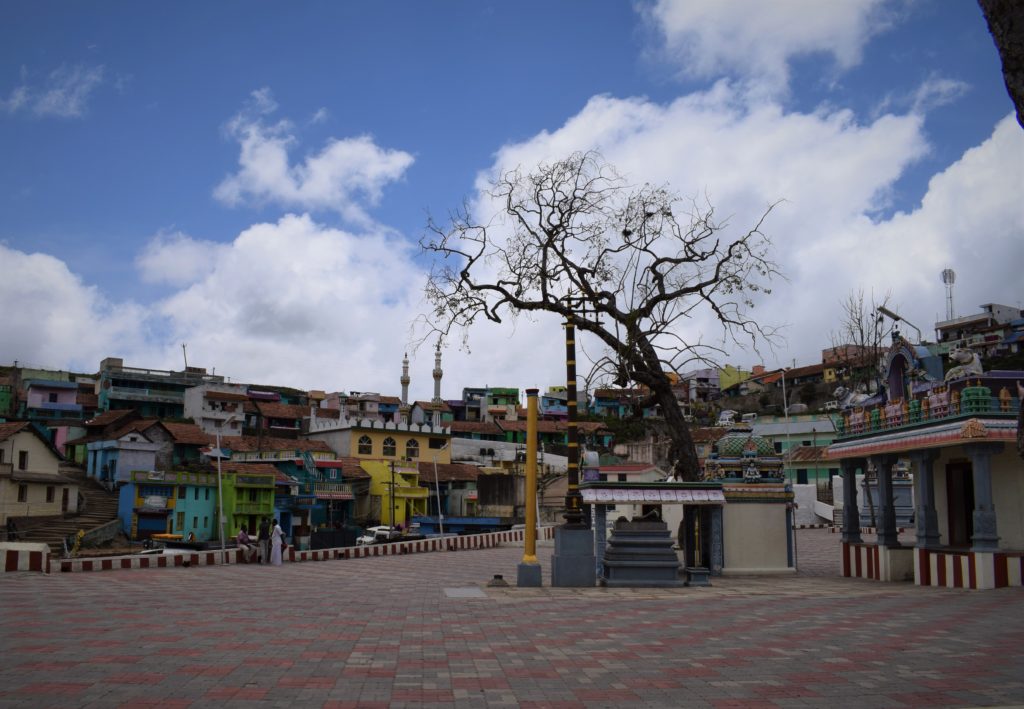
Table of Contents
Poombarai Murugan Temple Near Kodaikanal, India
Kodaikanal is just another one of those hill stations! Is that what your thoughts are about Kodaikanal? Well, Kodaikanal is definitely the typical hill station that you find across India. Picturesque places that date back to the colonial era. Yes, Kodaikanal too has a lake, one can buy lots of homemade chocolates and go for long treks on misty mornings. But there are many hidden gems in and around Kodaikanal that infuse it with a unique character. For one the surrounding forests enchant with multiple ecosystems that include grasslands, rain forests, and sholas. And then there is the 3000-year-old Poombarai Murugan temple located in the middle of a colorful and picturesque village, enveloped in an aura of intrigue and mystery. A place that immediately awes and enchants you.
Approaching Poombarai Murugan Temple
One of the joys of traveling is visiting places that you never knew existed on the face of the earth. The thrill of new discovery is an ecstatic pleasure beyond compare. The serendipity of travel is always a special experience The familiar feeling of butterflies in the stomach enveloped us as we drove down a curving road that snaked downwards. The prospect of seeing a 3000-year-old temple and one that not many visited seemed exciting. We were on our way from Kodaikanal to the village of Poombarai, some 20 odd kilometers away.
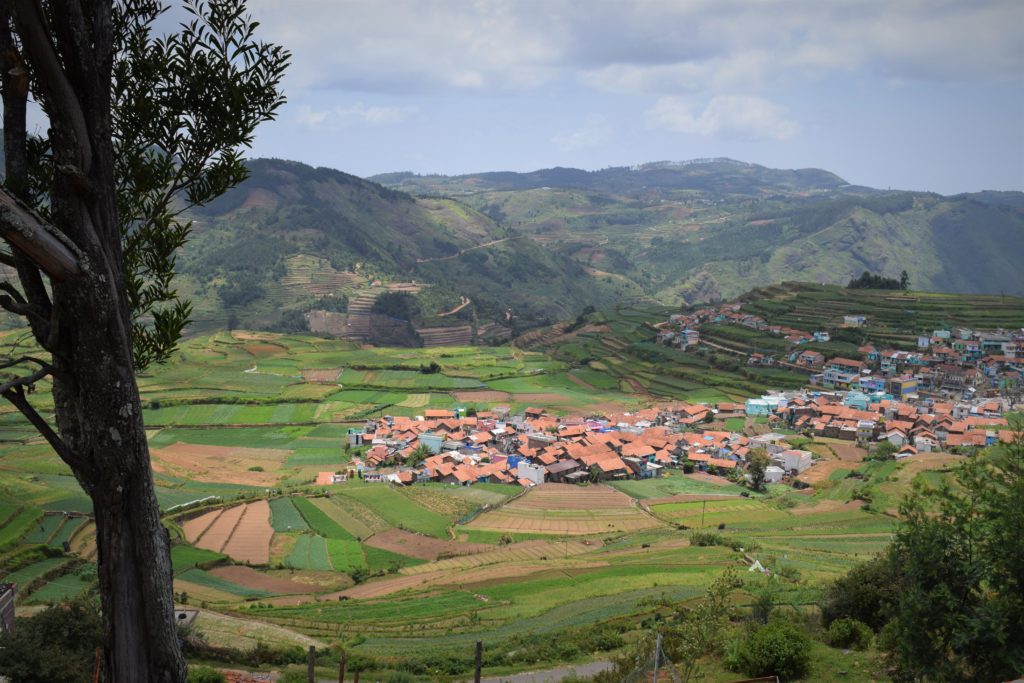
As we drove down to a valley hemmed by the lush green Palani Hills, suddenly the village of Poombarai stretched below in picturesque splendour. The Poombarai village view was absolutely enchanting. Tiny houses with red roofs huddled together. Terraced fields shone in emerald patches. The lush green Palani hills seemed to hover protectively in the background. If you are planning a trip to Poombarai, we strongly recommend stopping for a few moments before you descend into the valley. Take in the captivating view of the village before getting there.
Poombarai Murugan Temple – History And Associated Myths

The history of the temple is traced back to about 3000 years ago. The original temple is believed to have been built by a king of the ancient Chera dynasty that ruled over the region of Tamil Nadu. The Poombarai Murugan Temple, Kodaikanal is also known as Poomparai Kuzhanthai Velappar Temple. Here Kuzanthal refers to “infant”, and Velappar means, “holding a weapon”. This refers to the infant Muruga holding his traditional weapon, the spear, who is the presiding deity of the temple.
Have you heard about the Tamil Siddar named Bogar? A mystical saint who lived sometime between 550 to 300 BC. Bogar is the saint who is associated with the famous Palani Murugan Temple.also known as Dhandayuthapani Temple in Tamil Nadu. The same Bogar is associated with the Kuzhanthai Velappar Kovil Poombarai, Tamil Nadu.
Another interesting and historical association of the Poombarai, Kodaikanal Murugan Temple is that with another 15th century Tamil saint called Arunagirinathar. This said is credited with a number of songs in praise of the Lord Muruga and one of them, Poombarai Velan is said to be in praise of the deity at the Poombarai, Kodaikanal Murugan Temple.
The Fascinating Story of Bogar

The most intriguing aspect of the Poombarai Murugan temple is its association with the Tamil saint Bogar. The saint was credited with miraculous powers and was one of the 18 Tamil Siddhars considered most important according to Tamil beliefs and traditions. The Siddhars were enlightened beings with a wide knowledge of the disciplines of Alchemy, Medicine, Tantra, and Yoga. Many of them have been credited with miraculous powers including the ability to fly.

Bogar, is known for his spread of spirituality and spiritual practices to the lands of China. He is believed to have mastered the science of Alchemy and Yoga under his Guru Kalanginathar, who is believed to have been of Chinese origin. Kalaninathar after great penance and practice attained realization and tremendous powers in the region of Tamil Nadu and is one of the 18 Siddhars along with Bogar. It was Kalanginathar who asked Bogar to travel to China and spread the knowledge of the Sidda sciences. It is also believed that Lao Tse, the founder of Taoism, who propagated the duality of matter theory, could actually have been Bogar himself.
Bogar was a master alchemist who had extensive knowledge about chemicals, herbs, and their combined effects. It is believed that the idol of Lord Murugan was made by Bogar. He mixed nine poisons and 4448 medicinal herbs to create a master medicine or antidote and from that shaped the idol of Lord Murugan. The water and the Panchamritha used to worship the idol was this endowed with miraculous healing properties based on the esoteric science of Alchemy. Even today, thousands flock to the Palani temple to partake of this elixir said to have remarkable healing properties.
The idol of Lord Murugan at the temple of Poombarai is also said to have been created and consecrated by Bogar and similar to the one in Palani. This idol too is believed to have been made with the Navabashanam or nine poisons or Dasabashanams mixed with 4448 medicinal herbs. This is what makes the temple in the small village of Poombarai so important.
Bogar himself is said to have worshipped the idol of Lord Muruga in Palani regularly. He had a disciple named Pulippani to whom he taught the secrets of Alchemy and other esoteric practices. Bogar used to meditate inside a cave in the Palani Hills with Pulippani guarding the entrance. One day Bogar entered the cave and on his bidding, his favorite disciple closed the opening with a stone. Bogar is said to be meditating inside the cave to this day in Nirvikalpa Samadhi. Puilippani and his descendants guard the cave entrance and ensure that the worship of Lord Murugan continues even to this day.
Poombarai Murugan Temple – Architecture And Layout

The temple does not awe you with its presence. It does not have the grandeur that one associates with the temple architecture of Tamil Nadu. If you are expecting the grand scales of the temples of Kanchipuram, Thanjavur, or Madurai, you will be disappointed. Neither does the temple have the grace of the rock temples of Mahabalipuram. It is a small temple with some stone carvings that have survived the passage of time. The main temple with a couple of smaller temples stands in the center of a sprawling complex. The temple complex stands in the center of the village occupying center stage, so to say.
An old tree lends a mystical aura to the temple. But what makes the temple really important is the history and myths that are associated with it. Particularly the small idol of Lord Murugan and its miraculous conception and properties.
Poombarai Village

The village of Poombarai which looks beautiful from up in the hills is actually non-decrepit when you descend into it. It is like any other Indian village. Flower sellers sit outside the temple hawking their wares. What draws your attention is the piles of garlic that many of the vendors are selling. Garlic outside a temple? you wonder. But further inquiries reveal that the village is famous for the quality of Garlic that they grow and it is, in fact, one of its chief crops. There is no connection of the Garlic with the temple whatsoever.
The village of Poombarai has a little over a 1,000 houses and is located in the Dindigul district of Tamil Nadu. Dindigul to Poombarai distance is about 117 km. Though it is ensconced in a valley surrounded on all sides by the Palani hills, the village is about 6,300 feet above sea level.
Places To See Near Poombarai
There are many places to see near Poombarai. Of course, Kodaikanal with all its attractions itself is about 20 km. away. A few other places that we recommend one visit when you are at Poombarai are:
The Berijam Lake
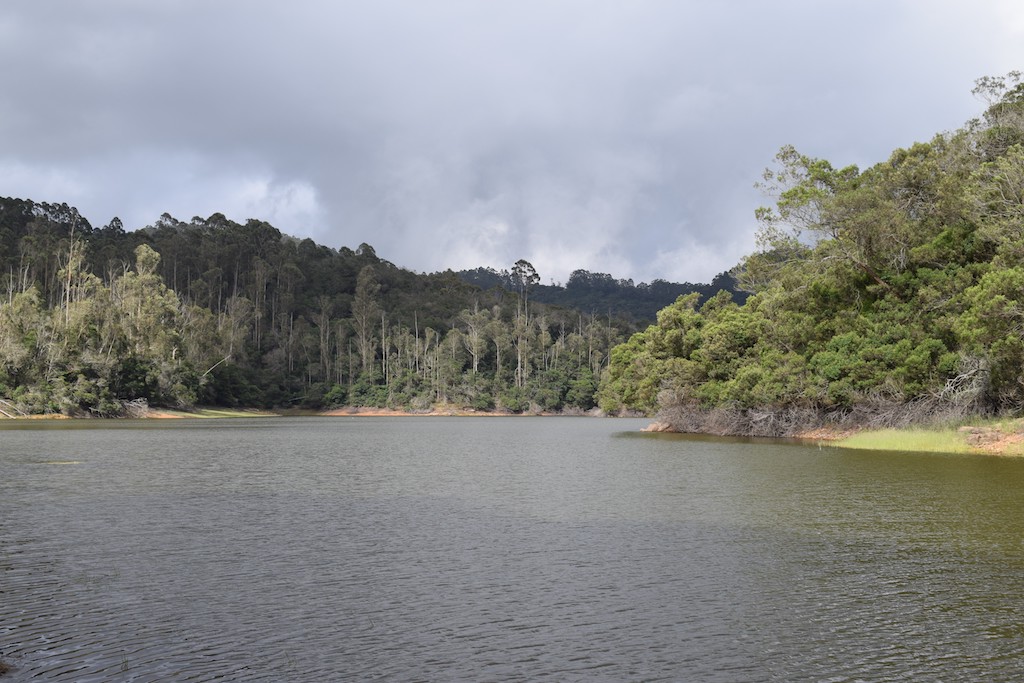
A lake that lies at a distance of about 26 km. It is an enchanting and serene lake in the midst of hills. A place that is not visited by many and hence a great place to relax and lose oneself in the beauty of nature.
Manavannur Eco-Tourism Site
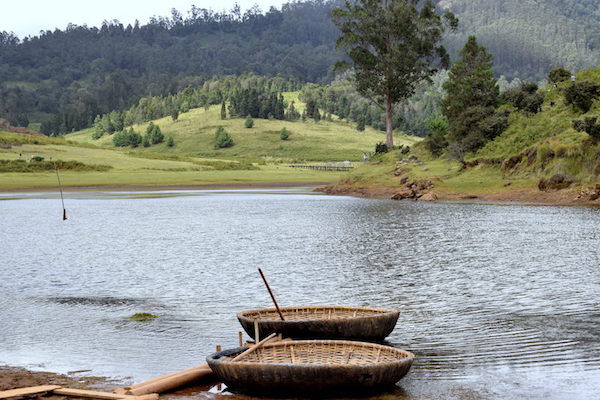
A nice place to spend in the natural environs is the Manavannur Eco-Tourism site. The place is about 17 km from Poombarai. A beautiful lake, green meadows, hills in the background. A nice place for leisurely trekking and picnicking.
How To Get To Poombarai Murugan Temple
- The temple is located in the village of Poombarai in Dindigul district at a distance of about 20 km from the hill station of Kodaikanal
- One can get to the village by public bus from Kodaikanal or hire a taxi
- The nearest airport to Poombarai is in Madurai while the nearest railhead is at Dindigul
Quick Facts About Poombarai Murugan Temple
- The Poombarai temple is reputed to be over 3000 years old
- The temple is famous for its association with the Tamil Siddhar Bogar
- The most important aspect of the temple is its idol of Lord Murugan
- The idol is said to have been made and consecrated by Bogar
- The idol is said to have been made of 9 poisons and 4448 medicinal herbs just like the one in the famous temple of Palani
- The temple is also referred to as Subrahmanya Temple in Kodaikanal or Kuzhanthai Velappar Temple
- The Palani to Poombarai distance is about 84 km.
- The Poombarai Kodaikanal distance is about 20 km.
- The Poombarai weather is pleasant throughout the year as it is at a high altitude
- There is no entry ticket to visit the temple
Where To Stay In Poombarai
Poombarai is a small village, so if you are thinking of Poombarai resorts of Poombarai hotels, you need to think in terms of staying in Kodaikanal or its outskirts. There is no dearth of accommodation options in Kodaikanal. We had stayed in the lovely environs of the Great Trails by GRT, a beautiful property in a valley surrounded by misty hills.
Final Thoughts About the Temple of Poombarai
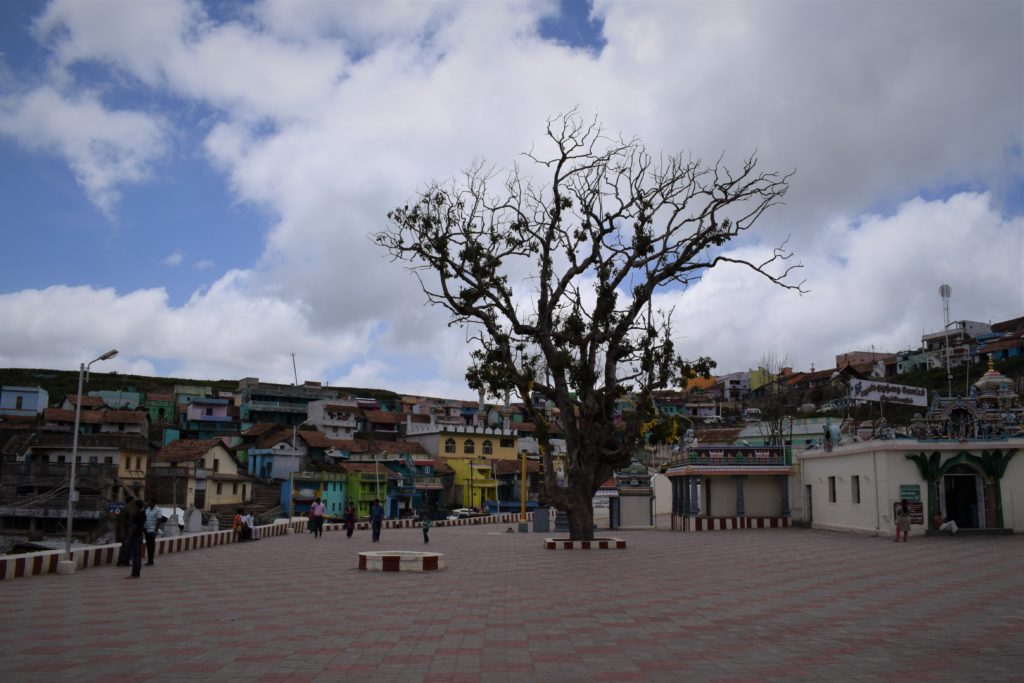
The temple of Poombarai is not just another of the countless that dot the length and breadth of India. The looks of the temple are deceptive, but the temple holds the ancient secrets of alchemy and spirituality as practiced by the ancient Siddhars. It may indeed hold the key to the elixir of immortality itself. Humbled by these thoughts, we looked back for one last look at the temple. No Poombarai photos can do justice to the mystical aura that seemed to envelop the temple at that moment. The sprawling complex of the temple with a dry tree in the center seemed to tell a tale of the realms of consciousness beyond the comprehension of ordinary minds.
Do You Love Traveling?
Do you want to know how to travel the world? We have put together a very useful travel resources page with best travel tips. Go check it out now.
Thanks for visiting our site Voyager – imvoyager.com and taking the time to read this post!
If you wish to collaborate/work with us then reach us at imvoyager18@gmail.com
We’d love if you’d comment by sharing your thoughts on this post and share this post on social media and with your friends.
[shareaholic app=”share_buttons” id=”27413782″]
Follow our journey on our social media channels:
Facebook Twitter Instagram Pinterest G+ YouTube
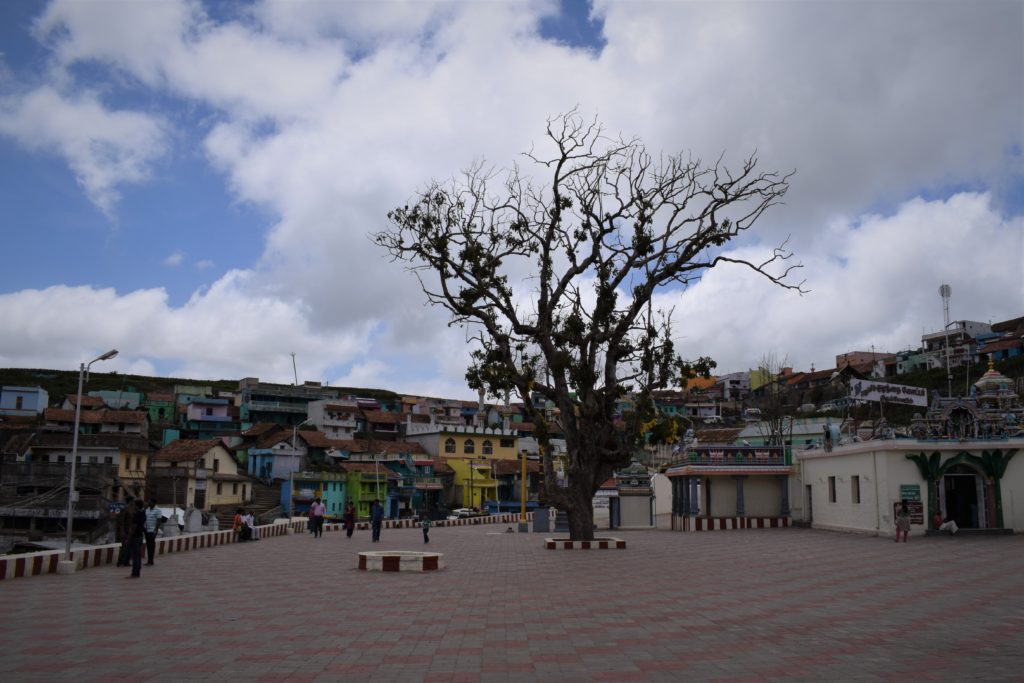




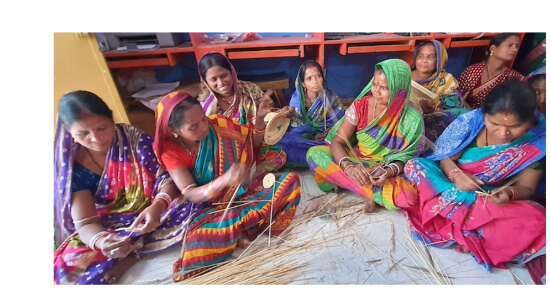
What an informative post this is! I had never heard of Poombarai Murugan temple before coming across your post but its fascinating history and these lovely pictures make me want to visit it.
Thanks for bringing this little area in Kodai alive with your words. I’ve been here only once and can’t wait to go back.
I love mythology and Indian mythology never disappoints. This post has me intrigued and I wanna know more about Bogar. Esply how can we reach his meditation caves
India has many mesmericing places to visit, glad to have bumped in here and caught this beautiful place. Calm, tranquil and green.
There are so many good temples in India we are not even aware of and I feel proud that you shared this will sure share with my mom as she loves travelling
I have heard about this temple before but didn’t get chance to visit yet. This is such an informative post. Bookmarking for future reference.
I have heard about this place from a cousin who recently visited the place. Now I can see why she was all praises about the place.
Heard a lot about kodiakanal and it’s breathtaking scenery, temple have lot of history attached to it.
So many things to explore in the Poombarai village. The Poombarai market, temple and berijam lake
Wao! Im so amazed by such minute details you have kept in the blog ; your hard work shows and i knew about kodaikanal but this temple i would have completely missed if not read your post!
My trip is sorted with your blog
Homemade chocolates and long treks, who can say a no to these? 😛
The temple looks beautiful… I had never heard of bogar! Thank you for sharing!
Wow! I had no idea about Bogar and the chinese saints! This is amazing… The temple pictures are beautiful! India is really a beautiful, diverse and culturally rich country!
This is a must visit hill station to explore beautiful architecture of Indian history. I love the view from the hills, it is so serene and calming.
Wow, that’s some temple and history, quite exhaustive in detail. We’ve been to Kodaikanal but since we usually avoid visiting temples during our travels we probably must have missed it. But after reading your post, I feel we missed a wonderful gem of an ancient era. We would plan again for sure.
I have been to Kanchipuram but not visited Kodaikanal.The temple of Poombarai sounds intriguing.Alchemistry secrets are absolutely awe inspiring.
The architecture of these temples is mesmerising. It’s amazing to see you bringing these places alive. These are like hidden treasures of our country.
I have been to this temple. This is such peaceful and heavenly place. I always recommend this to temple to anyone who is travelling to Kodaikanal.
This video is a beautiful tribute to the Poombarai Temple!The video effectively conveys the temple’s significance, making it a compelling view for anyone interested in spirituality, history, and the mysteries of India’s ancient temples.